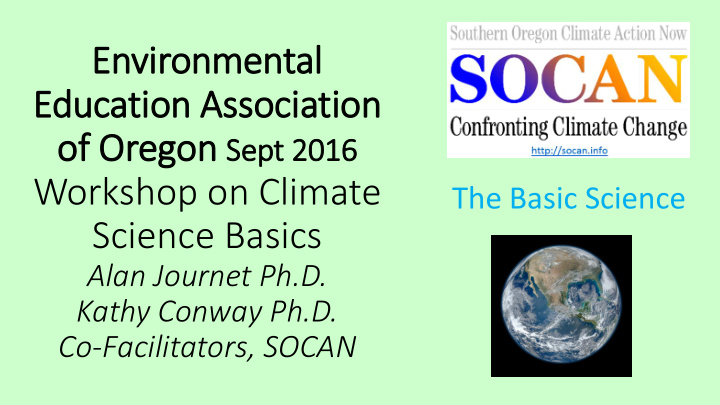



Environmental Education Association of Oregon Sept 2016 Workshop on Climate The Basic Science Science Basics Alan Journet Ph.D. Kathy Conway Ph.D. Co-Facilitators, SOCAN
Directions – Basic Science 1. Examine the images; analyze and interpret them (8 minutes) 2. Arrange them into a sequence that tells the basic scientific story of global warming (8 minutes) 3. Use your images to tell your story to another team (9 minutes) 4. Summary (5 minutes)
The Spectrum of Incoming Radiation Depicts the wavelengths of incoming solar radiation reaching Earth, their relative energy intensity, and the proportion reaching the Earth’s surface. High h energy ergy Visibl ible e Heat at Microwaves short ort medium dium long TV/Radio wave velen lengt gths hs wave velen lengt gths hs wave velen lengt gths hs FM-AM (black) (colors)
Transformation of Radiation at Earth’s Surface Hot bodies Cooler bodies emit radiation emit radiation in shorter wavelength form = in longer wavelength form Visible and UV Light Energy = Heat Energy Heat wavelengths Depicts the transformation of incoming solar radiation from shortwave to outgoing longwave infra-red / heat radiation
Outgoing long Incoming short wavelength infra-red / wavelength heat radiation visible radiation The Transformation of Some infra-red / heat is Incoming Radiation into absorbed by atmospheric gases Outgoing Radiation Depicting the solar radiation transformation that causes atmospheric warming NOTE: Absorbency is in lower atmosphere – which is where we live
Less escapes into space The Transformation of If atmospheric gas Solar radiation with density increases, more heat is retained increased atmospheric by this ‘thermal blanket’ greenhouse gas concentration Surface - Lower Depicting how increasing atmospheric Greenhouse Atmosphere Gas concentration causes atmospheric warming
Global Temperatures 1880 – 2015 2015 cf cf 1951-1980 Depicting the pattern of global atmospheric temperature since records were first collected 1.8 1.46 1.08 0.72 ⁰F 0.36 0 -0.36 .-0.72 http://data.giss.nasa.gov/gistemp/graphs_v3/Fig.A2.gif
The Main Greenhouse Gases The main greenhouse gases and their Global Warming Potential (GWP) Methane Carbon dioxide 100 year GWP = 34 100 year GWP = 1 20 GWP = 86 CFC / HCFC Longevity ≈ centuries Longevity ≈ decade 100 year GWP > 5,000 Nitrous oxide Longevity ≈ 250 years Longevity ≈ 10 Days 100 year GWP = 298 Water Longevity ≈ century Dihydrogen monoxide
Atmospheric Greenhouse gas Concentrations from Ice Core and Modern Data Depicting the pattern in atmospheric concentration of major greenhouse gases over this millennium Carbon dioxide Nitrous oxide Methane
Environmental Education Association of Oregon Sept 2016 Workshop on Climate Competing Hypotheses Science Basics Alan Journet Ph.D. Kathy Conway Ph.D. Co-Facilitators, SOCAN
Competing Hypotheses • Background - An Everyday Example • What might you do? • Engage in random acts of hope and desperation – like polishing the screen • Pray for Divine intervention • Assert the TV is really working and sit and watch the blank screen anyway • Give up and read a book • OR • Try science … generate and test hypotheses…
Competing Hypotheses • An everyday illustration of Competing Hypotheses • 1 - The remote is not switched to ‘TV’ • 2 – The TV is not plugged in • 3 – The power connection to the TV is broken • 4 – The power strip is turned off • 5 – The circuit breaker for the TV line is off • ONLY if / when these have been falsified would we infer the TV is broken.
The Competing Hypotheses to explain the global temperature increase Task is to evaluate whether your data image(s) support(s) your assigned hypothesis 1. Solar Radiation 2. Volcanoes 3. El Niño Southern Oscillation ENSO 4. Milankovitch Cycle 5. Greenhouse Gases
NASA GISS Global Atmospheric Temperature Trend 1880 - 2015 http://data.giss.nasa.gov/gistemp/graphs_v3/Fig.A2.gif
Directions – Competing Hypotheses 1. Examine your image(s); discuss how well the data in your image(s) support the hypothesis on your global temperature history graph. Identify a spokesperson to share your analysis with the workshop participants (10 minutes) 2. Team spokesperson shares your data (we will have the slides available) and conclusions with other workshop participants (10 minutes). 3. Summary – wrap-up
NASA GISS Global Atmospheric Temperature Trend 1880 - 2015 http://data.giss.nasa.gov/gistemp/graphs_v3/Fig.A2.gif
Hypothesis 1 – Solar Radiation Depicting the pattern of solar radiation activity and global temperature from 1880
NASA GISS Global Atmospheric Temperature Trend 1980 - 2015 http://data.giss.nasa.gov/gistemp/graphs_v3/Fig.A2.gif
Hypothesis 2 – Volcanoes Depicting what happens to global temperature following major volcanic eruptions
Volcanoes and Atmospheric Carbon dioxide trends Depicting the impact of volcanic eruptions on the general atmospheric carbon dioxide trend http://blogs.edf.org/climate411/2007/05/21/volcanoes/
Volcanoes and Stratospheric aerosols Depicting the impact of volcanic eruptions on the concentration of atmospheric aerosols reflecting incoming radiation http://images.intellicast.com/App_Images/Article/175_16.jpg
Volcanoes, stratospheric aerosols, and temperature trends Depicting the impact of volcanic eruptions on the atmospheric aerosol content and temperature http://earthobservatory.nasa.gov/Features/Aerosols/page3.php
NASA GISS Global Atmospheric Temperature Trend 1980 - 2015 http://data.giss.nasa.gov/gistemp/graphs_v3/Fig.A2.gif
Hypothesis 3 – El Niño Southern Oscillation El Niño / La Niña and Temperature El Niño warming La Niña cooling Depicting the relationship between El Niño and La Niña (ENSO) phases and global atmospheric temperature; SST = Sea Surface (Atmospheric) Temperature Nino 3.4 is location where data were collected
NASA GISS Global Atmospheric Temperature Trend 1980 - 2015 http://data.giss.nasa.gov/gistemp/graphs_v3/Fig.A2.gif
Hypothesis 4 – Milankovitch Cycles Milankovitch and Temperature Depicting the cycle in the shape of Earth’s orbit around the sun over a 100,000 year cycle
Depicting the cyclic pattern in the axis of the Earth’s tilt over a 41,000 year cycle
Depicting the cyclic rotation in the axis of the Earth’s tilt over an approximately 20,000 year cycle
Glaciation Glaciation Glaciation Glaciation Depicting the relationship between the Milankovitch Cycles and current temperature
NASA GISS Global Atmospheric Temperature Trend 1980 - 2015 http://data.giss.nasa.gov/gistemp/graphs_v3/Fig.A2.gif
Atmospheric Greenhouse Hypothesis 5 – Greenhouse Gases Gas Concentrations for Two Millennia http://www.global-greenhouse-warming.com/greenhouse-gas.html
Admonitions • Include discussion on ‘what we can do’ • Be positive and optimistic about our collective prognosis • Contact us for questions • socanhotline@gmail.com • http://socan.info
Recommend
More recommend